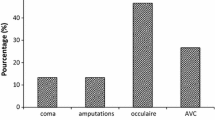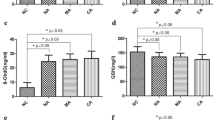Abstract
Oxidative stress has been implicated in the pathogenesis of the chronic complications of diabetes mellitus but little is known in diabetic ketoacidosis (DKA). The aim of this work was to determine whether lipid peroxidation, as assessed by measuring malondialdehyde (MDA, a prooxidant) and antioxidant status (TAS, an index of antioxidant defenses), is modified in DKA, and also whether any observed abnormalities were related to metabolic disturbances. Methods: four groups of patients were studied, comprising 19 patients with DKA, massive ketonuria and plasma standard bicarbonate levels below 16 mmol/l (group 1); 20 patients with poorly controlled diabetes, glycated hemoglobin (HbA1c) above 8% and plasma bicarbonate levels above 16 mmol/l (group 2); 11 patients with well-controlled diabetes and HbA1c below 8% (group 3); and 10 non-diabetic, non-obese control subjects (group 4). Metabolic parameters, MDA levels and TAS were assessed in the plasma of the four groups of subjects. Results: mean plasma MDA and TAS values were significantly different among the four groups (respectively p<0.001 and p<0.01). Mean plasma MDA value was significantly higher in group 1 than in group 3 (p<0.02) and group 4 (p<0.001) but was not different from that in group 2. Mean plasma MDA value in group 2 was significantly lower than that in group 4 (p=0.002). Mean plasma TAS value in group 1 was significantly lower than in groups 3 (p<0.002) and 4 (p<0.05). Mean plasma TAS value was significantly lower in group 2 than in group 4 (p<0.05). Plasma MDA values in the diabetic patients (groups 1+2+3) were not related to any clinical characteristics (BMI, age, duration of the disease) or metabolic parameters (glycemia, HbA1c, bicarbonates, blood urea nitrogen, phosphatemia, lipids), while plasma TAS values correlated negatively with glycemia, osmolality and HbA1c. A significant relationship was also found between TAS and HbA1c in group 1 (p<0.05) and between MDA and HbA1c in group 3 (p<0.05). Correlations were also found between TAS and phosphatemia in group 1 (p<0.01) and between MDA and phosphatemia in group 2 (p<0.01). A positive relationship between MDA and cholesterol levels was found in group 1 (p<0.01). In conclusion, MDA values are increased and TAS values decreased in DKA and poorly controlled diabetes, and tend to correlate more with markers of diabetic imbalance than with markers of acute metabolic disturbances of DKA.
Similar content being viewed by others
References
Baynes H.N.W. Role of oxidative stress in development of complications in diabetes Diabetes 1991, 40: 405–411
Yue D.K, Mc Lennan S., Fischer E. Ascorbic acid metabolism and the polyols pathway in diabetes. Diabetes 1989, 38: 257–261.
Wolff S.P. Diabetes mellitus and free radicals. Br. Med. Bull. 1993, 49: 642–652.
Altomare E., Vendemiale G., Chicco D., Procacci V., Cirelli F. Increased lipid peroxydation in type II poorly controlled diabetic patients. Diabetes Metab. 1992, 17: 264–271.
Griesmacher A., Kindhauser M., Andert S.E., Schreiner W., Toma C., Knoebl P., Pietschmann P., Prager R., Schnack C. Enhanced serum levels of thiobarbituric-acid-reactive substances in diabetes mellitus. Am. J. Med. 1995, 98: 469–475.
Santini S.A, Mara G., Giardina B., Cotroneo P., Mordente A., Martorana G.E., Manto A., Ghirlanda G. Defective plasma antioxydant defenses and enhanced susceptibility to lipid peroxydation in uncomplicated IDDM. Diabetes 1997, 46: 1853–1858.
Kaji H., Kurasak M., Ito K. Increased lipoperoxide value and gluthatione peroxydase activity in blood plasma of type 2 (non insulin dependent diabetic women). Klin. Wochenschr. 1985, 63: 765–768.
Uzel N., Sivas A., Uysal M., Oz H. Erythrocyte lipid peroxydation and gluthathione peroxidase activities in patients with diabetes mellitus Horm. Metab. Res. 1987, 19: 89–90.
Gallou G., Ruelland A., Legras B., Maugendre D., Allanic H., Cloarec L. Plasma malondialdehyde in type I and II diabetic patients. Clin. Chem. Acta 1993, 214: 227–231.
Ndahimana J., Dorchy H., Vertongen F. Erythrocyte and plasma antioxidant activity in diabetes mellitus type I. Presse Med. 1996, 25: 188–192.
Jos J., Rybak M., Patin P.H., Robert J.J., Boitard C., Thevenin R. Antioxidant enzymes in insulin-dependent diabetes in the child and adolescent. Diabetes Metab. 1990, 16: 498–503.
Maxwell S.R., Thomason H., Sandler D., Leguen C., Baxter M.A., Thorpe G.H., Jones A.F., Barnett A.H. Antioxydant status in patients with uncomplicated insulin-dependent and non-insulin-dependent diabetes mellitus. Eur. J. Clin. Invest. 1997, 27: 484–490.
Cerrelio A., Bortolotti N., Falleti E., Toboga C., Tonnutti L. Total radical trapping antioxydant parameter in NIDDM patients. Diabetes Care 1997, 20: 194–197.
Collier A., Wilson R., Bradley H., Thomson J.A., Small M. Free radical in type II diabetes. Diabet. Med. 1990, 7: 27–30.
Bono A., Caimi G., Catania A., Sarno A., Pandolfo L. Red cell peroxyde metabolism in diabetes mellitus. Horm. Metab. Res. 1987, 19: 264–266.
Arai K., Lisuka S., Tada S., et al. Increase in the glycosylated form of erythrocyte Cu- Zinc superoxyde dismutase in diabetes and close association of the non enzymatic glycosylation with the enzyme activity. Biochem. Biophys. Acta 1987, 924: 292–296.
Rabinovitch A., Wilma L., Suarez-Pinzon L., Strynadaka K., Jonathan R., Lakey R.T., Rajotte V. Human pancreatic islet β cell destruction by cytokines involves oxygen free radicals and aldehyde production. J. Clin. Endocrinol. Metab. 1996, 81: 3197–3302.
Rocie B., Vuci M., Kezebic-Cuca J., Radica A. Total plasma antioxydants in first degree relatives of patients with insulin dependent diabetes. Exp. Clin. Endocrinol. Diab. 1997, 105: 213–217.
Sumoski W., Baqurizo H., Rabinovitch A. Oxygen free radical scavengers protect rat islet cells from damage by cytokines. Diabetologia 1989, 32: 792–796.
Rabinovitch A., Suarez W.L., Thomas P.D., Strydnaka K., Simpson I. Cytotoxic effects of cytokines on rats islets: evidence for involvement of free radicals and lipid peroxydation. Diabetologia 1992, 35: 409–413.
Faure P., Corticceli P., Richard M.J., Arnaud J., Coudray C., Halimi S., Favier A., Roussel A.M. Lipid peroxydation and trace element status in diabetic ketotic patients: influence of insulin therapy. Clin. Chem. 1993, 39: 789–793.
Zozulinska M., Zawilska K. Evaluation of platelet malondialdehyde and 12-hydroperoxyeicosatetranoic acid in type I and type II diabetic patients with ketoacidosis and after clinical complications. Pol. Arch. Med. Wewn. 1991, 85: 286–293.
Olejnicka B.T., Dalen H., Brunk U.T. Minute oxidative stress is sufficient to induce apoptotic death of NIT-1 insulinoma cells. APMIS 1999, 107: 747–750.
Foster D., McGarry J. The metabolic derangements and treatment of diabetic ketoacidosis. N. Engl. J. Med. 1983, 309: 159–163.
Levi E., Fadda G., Ozbasli C., Massry S. Evolution of metabolic and functional derangements of pancreatic islets in phosphate depletion. Endocrinology 1992, 131: 2182–2185.
Glinn M., Ni B., Irwin R.P., Kelley S.W., Lin S.Z., Paul S.M. Inorganic Pi increases neuronal survival in the acute early phase following excito-toxic/oxidative insults. J. Neurochem. 1998, 70: 1850–1855.
Author information
Authors and Affiliations
Corresponding author
Rights and permissions
About this article
Cite this article
Vantyghem, MC., Balduyck, M., Zerimech, F. et al. Oxidative markers in diabetic ketoacidosis. J Endocrinol Invest 23, 732–736 (2000). https://doi.org/10.1007/BF03345062
Accepted:
Published:
Issue Date:
DOI: https://doi.org/10.1007/BF03345062




